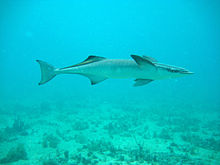| Remora Temporal range:
| |
|---|---|

| |
| Common remora, Remora remora | |
| Scientific classification | |
| Domain: | Eukaryota |
| Kingdom: | Animalia |
| Phylum: | Chordata |
| Class: | Actinopterygii |
| Order: | Carangiformes |
| Suborder: | Carangoidei |
| Family: | Echeneidae Rafinesque, 1810[2] |
| Genera[3] | |
| |
| Synonyms | |
|
Echeneididae | |
The remora (/ˈrɛmərə/), sometimes called suckerfish or sharksucker, is any of a family (Echeneidae) of ray-finned fish in the order Carangiformes.[4] Depending on species, they grow to 30–110 cm (12–43 in) long. Their distinctive first dorsal fins take the form of a modified oval, sucker-like organ with slat-like structures that open and close to create suction and take a firm hold against the skin of larger marine animals.[5] The disk is made up of stout, flexible membranes that can be raised and lowered to generate suction.[6] By sliding backward, the remora can increase the suction, or it can release itself by swimming forward. Remoras sometimes attach to small boats, and have been observed attaching to divers as well. They swim well on their own, with a sinuous, or curved, motion.
- ^ Friedman, Matt, et al. "An early fossil remora (Echeneoidea) reveals the evolutionary assembly of the adhesion disc." Proc. R. Soc. B 280.1766 (2013): 20131200.
- ^ Richard van der Laan; William N. Eschmeyer & Ronald Fricke (2014). "Family-group names of Recent fishes". Zootaxa. 3882 (2): 001–230. doi:10.11646/zootaxa.3882.1.1. PMID 25543675.
- ^ Eschmeyer, William N.; Fricke, Ron & van der Laan, Richard (eds.). "Genera in the family Echeneidae". Catalog of Fishes. California Academy of Sciences. Retrieved 16 November 2019.
- ^ J. S. Nelson; T. C. Grande; M. V. H. Wilson (2016). Fishes of the World (5th ed.). Wiley. p. 384. ISBN 978-1-118-34233-6. Archived from the original on 2019-04-08. Retrieved 2019-11-16.
- ^ "Sharksucker fish's strange disc explained". Natural History Museum. 28 January 2013. Archived from the original on 1 February 2013. Retrieved 5 February 2013.
- ^ Beer, Amy-Jane. Derek Hall. (2012). The Illustrated World Encyclopedia of Marine Fish & Sea Creatures. Leicestershire: Lorenz Books. p. 235. ISBN 978-0-7548-2290-5.